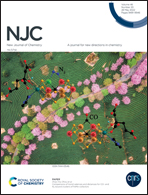A multifunctional nanoprobe based on europium(iii) complex–Fe3O4 nanoparticles for bimodal time-gated luminescence/magnetic resonance imaging of cancer cells in vitro and in vivo†
Abstract
The combination of complementary optical imaging and magnetic resonance imaging (MRI) techniques evolved to provide an even more powerful tool to simultaneously obtain both molecular information and anatomical information as well as to dramatically improve the accuracy of detection. Herein, we report a new tumor-targetable bimodal time-gated luminescence (TGL)–MRI nanoprobe for tracing cancer cells in vitro and in vivo. The nanoprobe was constructed by coating superparamagnetic Fe3O4 nanoparticles with functional silica shells that encapsulated luminescent Eu3+ complexes and were decorated with tumor-targeting molecules, folic acid (FA), on the surface. The fabricated nanoprobe possesses strong long-lived luminescence and excellent magnetic properties, as well as outstanding stability, biocompatibility and dispersibility in water. Furthermore, the nanoprobe can specifically bind to FA receptor-overexpressed cancer cells, allowing it to be accumulated in these cells. These features enable the nanoprobe to be successfully used for TGL imaging of cultured cancer cells and bimodal TGL–MR imaging of tumors in tumor-bearing mice with high sensitivity and accuracy. The research outcomes will contribute to the development of a new bimodal optical/MR imaging nanoprobe for the tracing and precise detection of cancerous cells.



 Please wait while we load your content...
Please wait while we load your content...